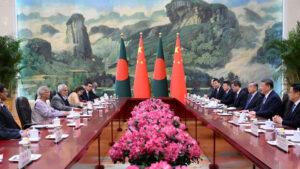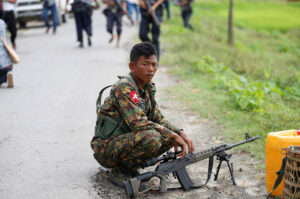A year marked by confrontation, capability shifts and dangerous rhetoric may be reshaping deterrence in South Asia. On Saturday, Pakistan’s Inter-Services Public Relations (ISPR) issued one of its starkest warnings in decades, cautioning that any future conflict with India “might lead to cataclysmic devastation” and vowing to respond “without any qualms or restraint.”
The statement followed a series of provocative remarks from India’s top brass. Army Chief General Upendra Dwivedi warned that Pakistan must end “state-sponsored terrorism if it wants to stay on the map,” while Air Chief Amar Preet Singh boasted that Indian forces had “downed five Pakistani fighter jets” during May’s confrontation — a claim Islamabad dismissed as “delusional and fabricated.” Defence Minister Rajnath Singh added that Indian soldiers were ready for any challenge, touting high morale and modern weaponry.
Behind the rhetoric lies a strategic development that could redefine Pakistan’s conventional deterrence posture: the creation of the Army Rocket Force Command (ARFC) in August 2025. Established just three months after the May conflict, the new command reflects Rawalpindi’s determination to field a long-range conventional strike arm capable of reaching deep into enemy territory without crossing the nuclear threshold.
A New Normal of Deterrence
Pakistan’s reference to a “new normal of response” signals a doctrinal pivot — from limited, localised retaliation to the capacity for decisive, long-range conventional strikes. The ARFC is designed to operate ballistic and cruise missiles, including systems with ranges from 70 km to over 700 km, such as Nasr and Babur, providing a credible option between conventional war and nuclear escalation.
The concept mirrors China’s People’s Liberation Army Rocket Force, which provides flexible, non-nuclear deterrence through precision strike capability. For Pakistan, this model offers the means to impose costs at depth while maintaining strategic restraint.
Lessons from the May Conflict
The four-day confrontation in May — the fiercest India–Pakistan clash in decades — saw both sides employ fighter jets, drones, and artillery in an intense exchange that left dozens dead. Both claimed victory; both suffered losses. Operationally, Pakistan’s early air performance was strong, but the conflict exposed the limitations of airpower alone.
The experience appears to have informed Pakistan’s decision to create a dedicated missile command. The ARFC consolidates long-range strike capabilities under a single structure, improving coordination, readiness, and command assurance. India, meanwhile, is pursuing its own Integrated Rocket Force, reflecting a mutual recognition that precision conventional strikes are now central to deterrence.
Escalation Risk
While the ARFC strengthens Pakistan’s conventional deterrence, the sharp tone of recent exchanges underscores a dangerous new normal in regional signalling. When senior officials openly speak of “erasing” a rival from the map or striking “without restraint,” they blur the line between deterrence and provocation.
In a nuclearised environment, such rhetoric can narrow decision-making space. With shorter warning times and ambiguous intelligence, even a tactical miscalculation could ignite a wider confrontation. Both capitals risk being drawn into a cycle where public posturing drives operational escalation.
Strategic Assessment
Pakistan’s creation of the Army Rocket Force represents a decisive maturation of its conventional deterrence posture. It seeks to plug the gap between conventional response and nuclear escalation, giving policymakers more flexibility and credibility in crisis scenarios. If successfully developed, the ARFC could become a cornerstone of Pakistan’s national defence architecture — a capability designed to deter Indian aggression through assured precision strike options, rather than reliance on nuclear threat alone.
For India, the message is twofold: Pakistan now has the means to project conventional firepower far beyond its borders, but the threshold for nuclear exchange remains unaltered. This raises the stakes for any future Indian pre-emptive or punitive operation, as the response calculus now includes deep conventional strikes.
At the regional level, the parallel evolution of Pakistan’s ARFC and India’s Integrated Rocket Force suggests that South Asia is entering a new phase of conventional deterrence competition. This competition may enhance short-term stability by giving both sides non-nuclear options — yet in the absence of restraint and communication, it also risks compressing decision time and increasing the chance of rapid escalation.
Ultimately, the strategic value of Pakistan’s Rocket Force will depend less on its range tables or payloads, and more on the doctrine that governs its use. If integrated with clear red lines, disciplined command and calibrated signalling, it could serve as a stabilising factor in an increasingly uncertain regional security environment.
Key Takeaways
- Pakistan’s Army Rocket Force adds long-range conventional strike capability to its deterrence posture.
- India’s planned Integrated Rocket Force mirrors this evolution, signalling a new arms dynamic.
- Precision deterrence may stabilise crises — or compress decision time dangerously.
- The outcome depends on doctrine, discipline, and restraint on both sides.

Amir Erez is a mission-driven OSINT Data Analyst specialising in defence and security intelligence, with deep expertise in open-source intelligence gathering, multilingual media analysis, and threat monitoring. Leveraging advanced data analytics, geospatial tools, and social media intelligence (SOCMINT), he delivers timely insights on emerging threats and real-time developments across South Asia and the Middle East/North Africa. Amir holds a Master’s degree in Strategic Studies from the Department of Military Science at Stellenbosch University, South Africa, blending academic rigour with operational insight to support defence and national security decision-making.



